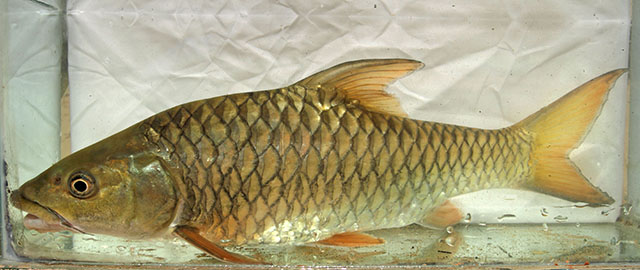
|
Tor khudree (Sykes, 1839) Deccan mahseer |
||
| Deccan mahseer, Arrayam, Atu kendai, Basra, Bili meen, Bilimeenu, Biriga, Black mahseer, Blue-fin mahseer, Iraham, Katta, Khadashi, Khadra, Khudchee, Khudree mahseer, Kudis, Kuyil, Mahseer, Meruval, Peruval, Poomeen, Pumeen, Warris, Yellow mahseer, കറ്റ, കുയില് | ||

|
|
photo by
Lockett, S. |
| Family: | Cyprinidae (Minnows or carps), subfamily: Torinae | |||
| Max. size: | 83 cm FL (male/unsexed); max.weight: 2,790.0 g | |||
| Environment: | benthopelagic; freshwater, potamodromous | |||
| Distribution: | Asia: India. | |||
| Diagnosis: | ||||
| Biology: | This species is mesopelagic, potadromous. Inhabits cool, fast flowing, rocky streams and rivers. Occurs in mountain lakes (Ref. 41236). Moves to upper reaches of small streams to spawn (Ref. 41236). Feeds on plants, insects, shrimps and mollusks. Can be cultured in ponds and lakes. Regarded to be of medicinal value. Known to grow over a meter and 45 kg in weight but have not been recorded in recent times (Ref. 41236). | |||
| IUCN Red List Status: | Least Concern (LC); Date assessed: 12 August 2019 Ref. (130435) | |||
| Threat to humans: | harmless | |||
| Country info: | Occurs in peninsular India. All available evidence suggests that the historic distribution range of T. khudree was limited to the northern and Central Western Ghats (current day Maharashtra, Telengana and Karnataka states) in the eastward flowing Krishna River system including its tributaries, the Indrayani, Mula Mutha, Koyna, Krishna, Tungabhadra and Panchaganga (Ref. 123532, 123533, 123534). Since the early 1970s, artificial propagation and national stocking augmentation policy has resulted in a dramatic expansion of the natural biogeographic range of this species (Ref. 123468). It now occurs as introduced populations in many parts of Central and south-western India. In the Western Ghats, it occurs as introduced populations in many rivers (Chalakudy, Periyar) and its associated reservoirs. With large numbers of fingerlings having been distributed throughout much of peninsular India (Ref. 56224), some of these introduced populations in South India are now known to be thriving and demonstrating invasive characteristics by limiting populations of endemic fishes, including other species of Tor (Ref. 105756). With respect to the native distribution range of Tor khudree, the frequently reported occurrence of this species in Sri Lanka remains subject of debate. Status of threat: Least concern (Ref. 123509). | |||